Blog: Getting it right with non-woodfuels
By Kevin Lindegaard, MD Crops for Energy and WHA Director.
From the name Wood Heat Association you’d be forgiven for thinking that we just cover woodfuels such as woodchip, pellets and logs. However, the remit of the WHA also includes the production of heat using straw, energy grasses such as Miscanthus and a myriad of other non-woody forms of biomass including pellets made from waste coffee grounds and briquettes made from bracken.
Many non-wood fuels are cheaper than their woody counterparts and are widely available in the UK. It’s quite possible that existing biomass system owners might like the idea of cutting their fuel costs by switching to using alternative fuels if woodfuel prices begin to rise. Also, developers of new projects might wish to consider cheaper non-wood fuels to assist the economic outlook of their scheme now that Renewable Heat Incentive (RHI) tariffs have been significantly reduced. It’s really important to consider all the options but also be aware of the issues of making such a choice.
At the WHA we encourage best practice and want to see an industry that delivers exemplary projects providing hassle free renewable heat to the user. In this blog we will deal with some of the crucial issues of non-wood fuels. Follow these pointers and you’ll be able to make an informed choice that takes into consideration your supply, your facilities and your lifestyle.
First things first – alternative fuels usually have poorer fuel qualities than woody fuels. For instance herbaceous fuels such as straw and Miscanthus have higher ash contents and lower ash melting points than woody fuels. Hence, there will be more frequent ash removal and typically more maintenance required. The table below indicates the relative amount of ash produced from 100 tonnes of fuel. The user would need to be geared up to handle and store the quantities involved. The larger quantities and the fact that ash is a useful fertiliser means that alternative fuels are generally most suited for farming scenarios.
Table 1: Ash content of different fuels and the relative amount of ash produced from 100 tonnes of fuel.
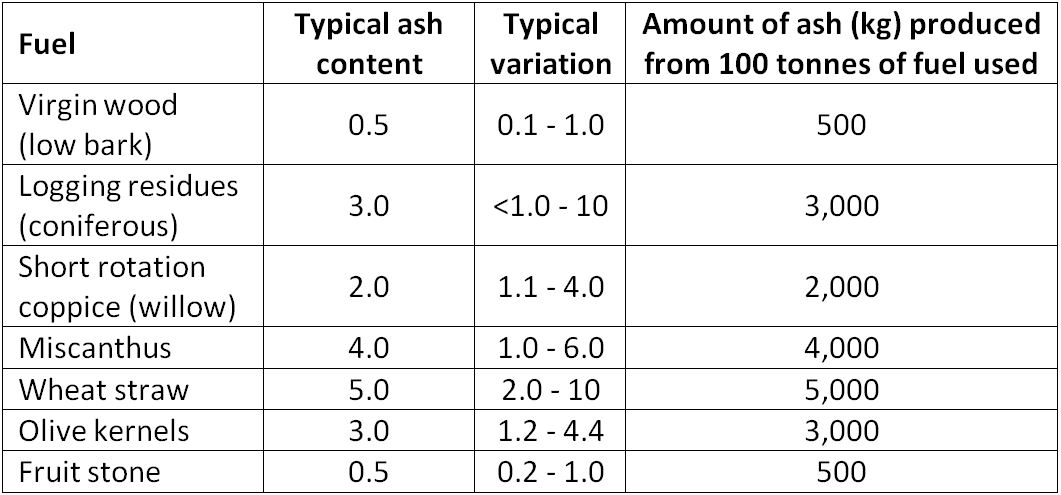
Figures from Solid Biofuels – Fuel specifications and classes Part 1 General Requirements. British Standard BS EN 14961-1:2010.
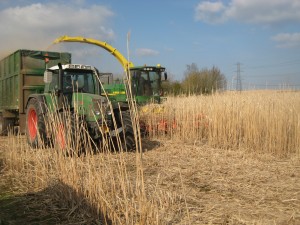 Furthermore, herbaceous fuels in bale and chip forms have a comparatively low bulk density. This means you’ll need more storage space and usually a bigger boiler – the reason for the latter is that the fluffy nature of the fuel means that you can’t physically get sufficient fuel into the combustion area to achieve the rated value of the boiler. As a result if your heat demand is 150 kW then you are likely to require a 200 kW boiler to meet the peak load when using Miscanthus chips. (Compressed fuels such as Miscanthus or coffee ground pellets and bracken briquettes do not have this issue).
Furthermore, herbaceous fuels in bale and chip forms have a comparatively low bulk density. This means you’ll need more storage space and usually a bigger boiler – the reason for the latter is that the fluffy nature of the fuel means that you can’t physically get sufficient fuel into the combustion area to achieve the rated value of the boiler. As a result if your heat demand is 150 kW then you are likely to require a 200 kW boiler to meet the peak load when using Miscanthus chips. (Compressed fuels such as Miscanthus or coffee ground pellets and bracken briquettes do not have this issue).
Matching the fuel of choice to your boiler is absolutely critical to the success of your project. Get it wrong and you will affect the warranty of your boiler and potentially shorten its life or be constantly replacing parts. Your boiler will need to be sufficiently robust to deal with the higher acidity of certain alternative fuels (for instance Miscanthus and straw have much higher levels of chlorine and sulphur than woody fuels). If your boiler is compliant to a wide range of fuels and you want to switch it’s a good idea to contact your installer. Some boilers have been designed to allow users to modify settings to enable simple fuel switching whereas others will require an engineer to visit and make the necessary changes.
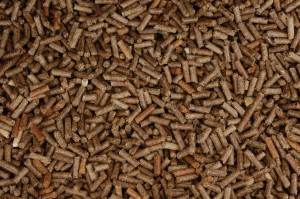 There are several boilers in the UK market that are compliant with alternative fuels. Many of these are available from WHA installer members. It really makes sense to do your homework and see if you can visit existing boilers and get some useful feedback from experienced users. Going to see boilers that have been in operation with a certain fuel for a number of years will increase your confidence in a system. Getting impartial third party advice and insight from an independent consultant can also pay dividends.
There are several boilers in the UK market that are compliant with alternative fuels. Many of these are available from WHA installer members. It really makes sense to do your homework and see if you can visit existing boilers and get some useful feedback from experienced users. Going to see boilers that have been in operation with a certain fuel for a number of years will increase your confidence in a system. Getting impartial third party advice and insight from an independent consultant can also pay dividends.
If you are intending to get your project accredited under the RHI you will need to make sure that the boiler has an RHI emissions certificate for the chosen fuel. Don’t take an installers word for it – make sure they provide you with this documentation before you sign a contract. Unfortunately many excellent boilers that are compatible for use with non-wood fuels don’t have the necessary certification. In this situation if you are really keen on a particular system and your non-wood fuel choice then you can organise an in situ emissions test using a specialist company. This can be quite costly and you would want to be confident that the system could achieve the emissions thresholds for particulates and nitrogen oxides (NOx) before you commit to this.
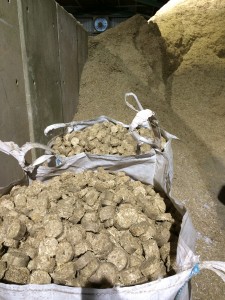 Another requirement of the RHI is to show that you are sourcing your fuel from a sustainable source and can demonstrate that the lifecycle greenhouse gas emissions are 60% below the EU fossil fuel average. The Biomass Suppliers List caters for woodfuels but up until now anyone using non-wood fuels has had to self-report which can be a relatively expensive and time consuming exercise. However, this gap should be filled by the launch of the Sustainable Fuel Register (SFR) which will be the first industry led, self-sustaining approved supplier list. The SFR is a joint initiative of WHA members Farm Energy Centre and Crops for Energy and once fully up and running (which is anticipated to be in the autumn of 2016) will be a subscription service with a small annual fee which takes into account quantity of fuel produced, traded or consumed. The SFR website is open for expressions of interest.
Another requirement of the RHI is to show that you are sourcing your fuel from a sustainable source and can demonstrate that the lifecycle greenhouse gas emissions are 60% below the EU fossil fuel average. The Biomass Suppliers List caters for woodfuels but up until now anyone using non-wood fuels has had to self-report which can be a relatively expensive and time consuming exercise. However, this gap should be filled by the launch of the Sustainable Fuel Register (SFR) which will be the first industry led, self-sustaining approved supplier list. The SFR is a joint initiative of WHA members Farm Energy Centre and Crops for Energy and once fully up and running (which is anticipated to be in the autumn of 2016) will be a subscription service with a small annual fee which takes into account quantity of fuel produced, traded or consumed. The SFR website is open for expressions of interest.
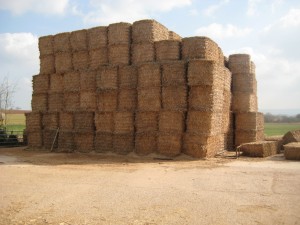 Finally, if you’re a farmer you might wish to supply your own fuel. An arable farmer would need around 25-35 hectares of cereals to supply a project requiring 100 tonnes of straw. Alternatively they would need to plant around 8 hectares of Miscanthus to produce the same quantity. There is a significant benefit to self-supply using energy crops. Once the crop is planted the farmer will be insulated against future price rises and as long as the crop is well tended should remain viable for 20 years.
Finally, if you’re a farmer you might wish to supply your own fuel. An arable farmer would need around 25-35 hectares of cereals to supply a project requiring 100 tonnes of straw. Alternatively they would need to plant around 8 hectares of Miscanthus to produce the same quantity. There is a significant benefit to self-supply using energy crops. Once the crop is planted the farmer will be insulated against future price rises and as long as the crop is well tended should remain viable for 20 years.
So there you have it – our quick guide to getting it right with alternative fuels. If you have your eyes open to these important issues you will be well on the way to embarking on a successful and rewarding project.
Note: The Board of Directors of the WHA will each month publish a blog on topics related to the biomass heating industry. The views expressed in this blog post are those of the author(s) and do not necessarily reflect the views or policies of the WHA/REA.

